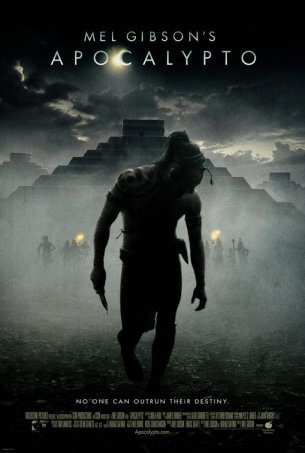|
Apocalypto
From
start to finish, Mel Gibson’s Apocalypto
is a nonstop fetishization of exquisitely rendered violence
– so beautifully orgiastic and blood-driven that upon
leaving the theater we were immediately overwhelmed with
the urge to find something to savagely brutalize and kill.
The
film centers on a young Mayan named Jaguar Paw (Rudy Youngblood),
whose family lives out their day-to-day lives in the jungles,
unaware of the declining civilization credited with spawning
a working calendar, astrological systems, mathematics, art,
architecture, and a written language. Unfortunately, Gibson’s
film is also unaware of these facets of Mayan civilization,
as it chooses to focus strictly on the brutal aspects of
the culture.
Granted,
the film is primarily an action film and never intended
to be an educational documentary chronicling the achievements
of an ancient civilization. I recall studying these ancient
civilizations, and while I would never claim to be an expert,
some of Apocalypto feels as though it is blending
together the sacrificial practices of Mesoamerican cultures
for the sake of “filling the blanks” in regards
to the true fate of the Mayans.
What
actually befell the Mayans is uncertain. Their exquisitely
designed cities, which had served as habitation for the
upper class, were all but abandoned towards the end, but
the reason for this abandonment is unsure. Gibson’s
film suggests that disease was spreading throughout the
Mayan society, driving its political and religious leaders
to call for nonstop sacrifices to appease their gods.
The
subjects of these sacrifices are unsuspecting villagers,
like Jaguar Paw’s tribe, who are rounded up en
masse and brought to the city to suffer their fate.
We see this world through the eyes of a villager who was
unaware that these cities even existed, all the while knowing
that his pregnant wife Seven (Dalia Hernandez) and their
first born child Turtles Run (Carlos Emilio Baez) are trapped
at the bottom of a crevasse.
And
this, sadly, is essentially the bulk of Gibson’s tale
– one man’s race against time and insurmountable
odds to save his family in a fictionalized version of an
ancient civilization. The formula is simple, and Gibson
adheres to his “death a minute” structure with
dogged dedication. The flow of blood is not confined to
the sacrificial ceremonies; Apocalypto would have
it that every waking moment of Mayan existence is plagued
with either the death or mean-spirited treatment of others.
Before
the human carnage begins, we are given the brutal and bloody
slaying of a jungle beast, followed by a series of sophomoric
jokes and pranks played on one member of the tribe who has
had trouble conceiving his first child. Following the exquisite
sacrifice sequences, the action returns to the jungle in
which all forms of peril befall Jaguar Paw. Gibson employs
every possible jungle stereotype imaginable, and then relies
on several Deus ex Machinas to narrowly maneuver
Jaguar Paw from one life threatening scenario to another.
Meanwhile,
still stuck at the bottom of her pit, Seven makes several
attempts to escape her own plight. Two of these attempts
result in Seven slipping and falling belly-first onto the
cold rock floor. Yes Mel, we get it – the proliferation
of Mayan culture is at risk, hence “pregnant belly
go smash…twice.”
I’ve
read reports for months that Apocalypto is, for
all intents and purposes, Gibson’s attempt at drawing
an allegory between the decline of the Mayans and the crisis
facing our current Western culture.
One
could see the ripe opportunity for a statement of this nature,
but nothing in Apocalypto appears to lean in this
direction, and Gibson even opens the film by quoting William
Durant, “A great civilization is not conquered from
without, until it has destroyed itself from within.”
If Gibson’s intent is to examine the internal decay
of an advancing civilization and compare it to our own then
his approach is faulted. His reasons for decay are too brief
and unsubstantiated to hold any real weight. He’s
too busy skewering his cast and eviscerating their remains.
If the
film appears to be taking a stance on anything at all it
would be the practice of blind allegiance to religious leadership
based on faulty interpretations of supposed signs. This
is jarringly odd considering Mel’s outspoken beliefs
and dedication to faith and devotion. After all, he credited
the Holy Ghost with directing The
Passion of the Christ, claiming that he was simply
“directing traffic.”
Admittedly,
my knowledge of Mesoamerican culture is a bit fuzzy, but
most of the sacrificial imagery and practices depicted in
Apocalypto is far more Aztec than Mayan. Both practiced
human sacrifices, but my recollection of Mayan sacrifices
are more in line with self-sacrifice, self-mutilation, and
bloodletting on behalf of Mayan leaders.
Undoubtedly,
a refresher course is likely needed, but Mel’s fixation
with brutality still takes an uneasy center stage here.
If it
is action you seek, Apocalypto is sure to deliver,
but if you wish for something deeper you will likely find
the film’s gratuitous nature a bit tedious. Remember
the fuss made over Jesus’ torture in The Passion
of the Christ and Mel’s lovingly devotion to
detail during the sequence? Imagine this type of brutality
stretched out over the entire runtime of the film. It begins
with the kill of a hunt, and escalates to all aspects of
life throughout the remainder of the film.
Just
because it breathes and can be killed, doesn’t mean
you have to actually go there, Mel.
Rating:

|








